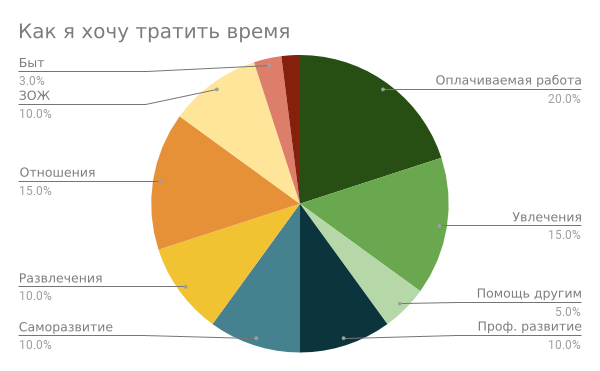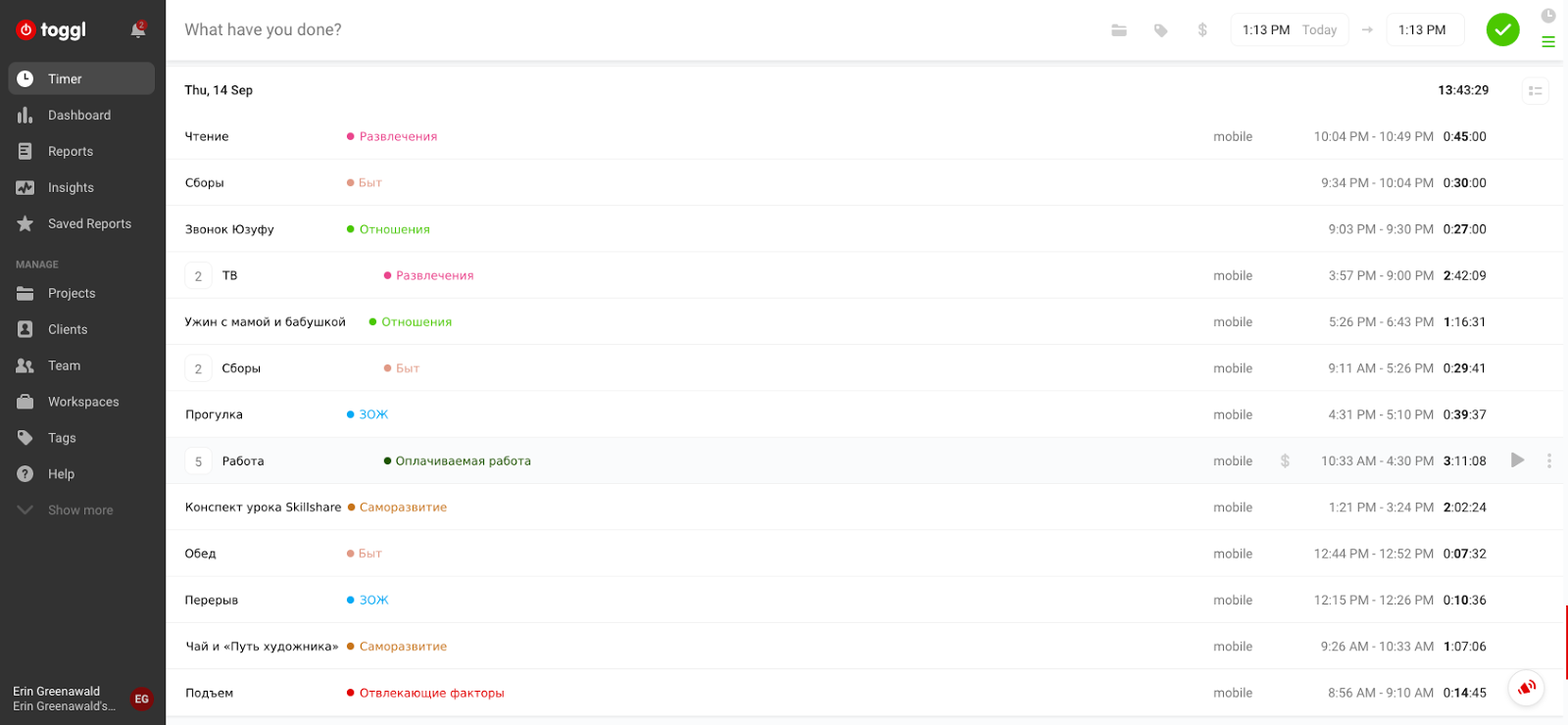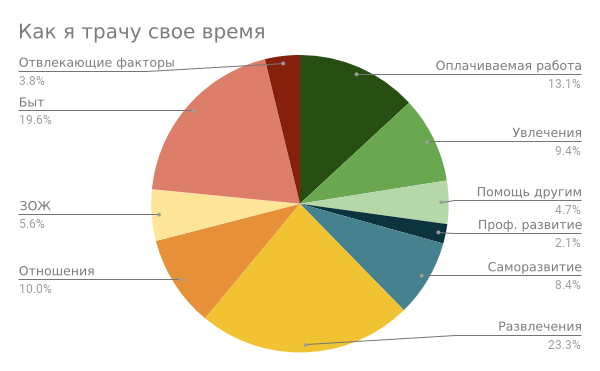Experiment to account for time, or What I learned by analyzing a whole month of my life

“The way we spend our days determines how we spend our lives. What we are doing at a particular moment is just what we are doing at all. ”It doesn’t matter what you consider your priorities: what you actually devote your time to is your chosen life priority. But how many people know what it takes every minute and every day of their lives?
- Annie Dillard
In one day, quite a few minutes - 1,440 to be exact. Even if we take into account the eight hours of sleep that a healthy organism needs, then it turns out that almost 1000 minutes remain for what we want to do. And yet at the end of the day it often seemed to me that the most important time was not enough. There had to be something that took more time than it deserved, and in order to stop wasting my life on trifles and spending time with more meaning, I decided to find out what it was.
')
Therefore, I set myself a goal for a month to take into account every minute of my time and check how my idea of how I spend my time corresponds to reality. In this article, I will tell you how I did it, what I learned, and why you should also do this. (I’ll open the veil of secrecy: tracking a budget allows you to distribute finances better, and accounting for calorie intake helps build nutrition, and timing can tell you how to handle the most valuable resource.)
Transferred to Alconost
Step 1. Select categories of classes
Month of the accounting of time is more than 43 000 minutes. It was necessary to come up with some general categories to which the pastime could be attributed - so the resulting data would make more sense.
Therefore, I thought about how I spend my days and what I want to devote my time to. After careful consideration, I have eight categories left:
- Paid work (for example, work for clients).
- Hobbies (for example, side projects).
- Professional development (for example, customer acquisition, exchange of experience and new professional contacts, applications for interviews).
- Self-development (for example, keeping a diary, visiting various classes and seminars, reading books that give inspiration).
- Relationships (for example, time spent with family, calls to friends, dates).
- Entertainment (eg, shopping, TV, reading optional texts, attending entertainment and walking).
- Healthy lifestyles (for example, physical exercises, breaks required for work, self-care).
- Help others (eg, volunteering, mentoring).
In addition, I didn’t want to break away from reality: we needed categories for some activities that I was not enthusiastic about - but the time it spent on them nonetheless:
- Distractions (for example, thoughtless sitting on social networks, long getting out of bed in the morning).
- Life (for example, all sorts of orders, fees, routine affairs).
In order to check whether every day was fully taken into account, I also took sleep into account, but did not include it in the analysis, since it already accounted for about a third of my time, and there was no need to change this. But if you want to make time for other activities at the expense of sleep, it would be better to include it in the analysis. I decided to focus only on how my wakefulness is going.
Most of these categories are likely to suit almost everyone, but there may be differences. Try to think carefully about what it takes your time and what you want to spend on it, even if you don’t spend time on these activities. Do not overload the list: just leave no more than 10 categories.
Step 2. Desired time distribution
During the experiment, I tried not to judge how I spend my time - just to track it as it is and to analyze it at the end - but I needed to focus on something in order to evaluate the results. I do not mean the assumption of what time is actually spent, but rather a vision of how I would like to spend my time.

When you take on this task, estimate how many hours a week you want to spend on something, and calculate the corresponding percentage. It’s convenient to focus on the week, because every day we can have very different classes (for example, weekends are different from weekdays), and in just a week you will receive a fairly accurate average grade.
Here you can allow ambitions to unfold - to imagine what you want to “ spend your own life ”, but you shouldn’t soar in the clouds: if you work from eight to five and do not plan to change it in the near future, then paid work will be about 40 hours in a week, or roughly 36% of the waking time.
Editor's Note. This approach will also provide a clearer idea of what working time is spent on: just pick up the categories that will divide the work day into different types of tasks.
Step 3. Tools
Now you need to pick up tools for time tracking. I have already used the Toggl service for work, and therefore I decided to track the wakefulness time through it. There are relevant applications for the iPhone and Android platforms - so you can mark the time on the go - as well as extensions for the Chrome and Firefox browsers. For each of the categories of classes, I created a project so that they can be easily tagged.

There are, of course, many other tools and ways to use them, so if you are used to another application, use it. You can, for example, add tracked activities to the Google calendar as events occurring during the day, and then use the Zapier application automation tool to save these events to the Google table and analyze them. You can also automatically track time spent in applications and on websites using the RescueTime service, and with a subscription you can also note off-line activities and keep a log of what was done for the day.
Looking for the right app? We have compiled a list of the best time tracking applications where you can compare their capabilities and find the right one.
Step 4. Start time tracking!
We turn to the most important thing. Decide what morning (immediately after waking up) you will start to take into account your time, put a reminder in the calendar about the end of the "experiment" in 4 weeks, and proceed!
The first thing I noticed when I began to track my classes was a great reluctance to do this. It was very difficult for me not to forget to mark everything, and it seemed that tracking took more time than was worth it. Looking ahead, I will say that now I am glad that I still forced myself to keep track of everything: in the end, I learned something interesting.
Nevertheless, I constantly forgot to mark the time spent on something - especially in the first week or so. Somewhere in a day of torment, I put a periodic reminder on the phone. In addition, I decided at the end of the day to check whether the whole day was taken into account.
I also immediately noticed that some classes are difficult to classify in any particular category.
Sometimes the reason was that it seemed to me that I was doing several things at once. For example, cooking: it seems to be a lesson from the “life” category, but at the same time I like cooking, this is a good rest, and if the food is especially healthy, it is a healthy lifestyle. But you can also cook together with someone else - then it can be seen as a contribution to the relationship.
In other cases, it was difficult to pinpoint what I was doing. The Internet is partly to blame for this: I noticed that I often sit there for work, talking with friends and acquaintances, or being distracted by videos with cats.
As a result, several rules helped me to distribute classes in convenient categories:
- Try to keep records as specific as possible. Remember that the goal - as accurately as possible to take into account every minute of wakefulness. Therefore, if you spent two minutes for a snack, then a minute for a text message to a friend and another 10 minutes for all kinds of fees, then each of the classes should be assigned to the appropriate category. Studies show that our brain is not really multi-tasking : it seems to us that we are multi-tasking, but in fact we just quickly shift our attention between several tasks (sounds familiar, right?). And this, too, needs to be remembered when tracking occupations: taking into account that it takes a minute or two to take effect may seem like a waste of time, but in a week or a month all this “trifle” will take shape and can give a tangible result.
- Distributing classes by category, mark them. The label can be a detailed description of what you actually did (for example: “watching TV” or “responding to emails”) - the category (“entertainment”, “work”, etc.) has a wider scope. Using tags together with categories is very convenient. First, if you forget to put something in the right category, it will be easier to do it later with a tag. Secondly, when analyzing the results, it will be possible to take a closer look at the largest categories that take too much time.
- In extreme cases, start the countdown immediately, and specify the category later. Service Toggl allows you to take into account the occupation, even if it does not specify a label or category. Therefore, if you’ve finished doing something and don’t know what to do next, simply start a timer: when after a while you stop the timer to switch to the next task, you can specify a category and put a label.
- Decide where to put the “lost” time. At the end of each day, I checked whether all time was taken into account. In most cases, it turned out that I did not take into account 10-30 minutes - I call it “lost time”: something memorable is not enough to get the idea to consider this. Probably, you will have the same, so think about what classes you usually “lose” time, and decide where to take it. I decided to include such cases in the category of "life": I think it was just those minutes when I went around the house and cleaned every little thing or going somewhere. Perhaps you know that you have a lot of time “lost” on social networks - then it’s better to take it to “distracting factors”, well, or somewhere else.
Step 5. Analysis of the results
So, four weeks have passed - time to analyze the results. Regardless of how you tracked your classes, I recommend calculating the total number of hours in each category and putting the data into a spreadsheet editor to make it easier to build graphs.
The Toggl service allows you to download a CSV file with data, which simplifies the work, but the data is presented in the form of hours and minutes - therefore, to work with them, you need to convert hours and minutes into one number. (Multiply the number of hours by 60 and add up with minutes - or divide the minutes by 60 and add up with the clock. So, 3 hours and 22 minutes will be 202 minutes, or 3.37 hours.) If you had another application for tracking time, maybe , the data will need to be converted in some other way.
When I did all this, the month I spent appeared as follows:

Let me remind you - the desired distribution was:

You can immediately notice that the amount of time I spend on "entertainment" and "life" is much more desirable, which is why less remain such important categories as work, development, relationships and healthy lifestyles.
If we look at the categories of “eaters” in more detail, we can better understand what takes time and how to change it. After analyzing the category of "entertainment", I saw that it was unacceptable a lot of time to watch TV - about a full working week per month! In my defense, I can say that in vain I began watching “Twin Peaks” this month, but thanks to this I was able to personally see the influence of the delaying TV shows and shows and wondered if I really wanted to spend my time that way. Of course, TV sometimes helps to relax well at the end of the day, but seeing how much time it takes, I thought that I could do something else and somehow combine this habit with the rest of the classes.
In the "life" category, I found that a lot of time was spent driving - more than I expected. However, this time I can definitely spend with more benefit - if you choose interesting podcasts that will promote self-development and professional growth.
Obviously, your priorities and numbers will be completely different, but when you review your results, try to be honest with yourself. What time spent on what classes does not please you? What would you like to pay more attention to? What takes away too much time from you, on what can you “save” in favor of other activities?
I was also surprised how much the tracking of what I was doing affected some bad habits. During these 4 weeks:
- I began to spend time more consciously. Already what I take into account every minute was enough for me to better understand how my days are going on - and this is a step to stop wasting time as I do not want it. Opening Instagram on the morning, I started the timer - it was not enough to immediately stop, but it was enough to exit as quickly as possible and stop the timer.
- In my life, there is less multitasking. The need to take time into account made me more “one-task”. It is difficult to keep track of classes if you constantly switch between them, so more often I limited myself to one thing, and only then moved on to the next task.
Finally, thanks to this experiment, I was able to estimate how much time actually fits into one day. Looking calmly and soberly, how much I was able to do during the day, week, month, and how much time was wasted, now I can’t say so easily that I don’t have time for something. It is completely obvious to me that there is time — that is, you just need to carefully prioritize.
Accounting for time is not needed to feel its worthlessness or the obligation to get rid of bad habits - it is needed just to get information. Looking at the data, you may not want to change anything - or vice versa: your eyes will open and you will turn your life. But in any case, now you will know exactly what the precious moments of life take.
About the translator
The article is translated in Alconost.
Alconost is engaged in the localization of games , applications and sites in 68 languages. Language translators, linguistic testing, cloud platform with API, continuous localization, 24/7 project managers, any formats of string resources.
We also make advertising and training videos - for websites selling, image, advertising, training, teasers, expliners, trailers for Google Play and the App Store.
Read more: https://alconost.com
Source: https://habr.com/ru/post/346896/
All Articles